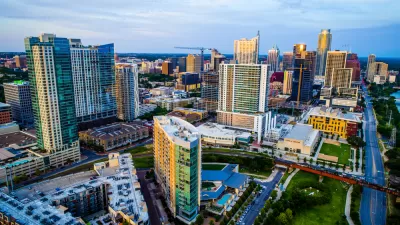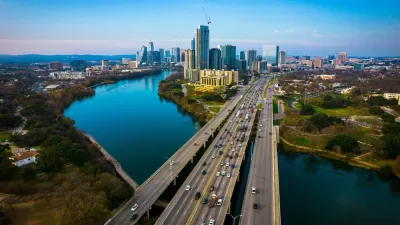A proposal to widen I-35 has drawn criticism from community members who want to see the city shift away from car-centric development.

Austinites are engaged in a heated debate over the Capital Express Project, a controversial "$7.5 billion plan to expand the abhorred stretch of I-35 that snakes through the center of Austin" by adding two levels of tunnels and adding several new lanes. As reported by David Leffler, transportation advocates argue that the plan is "the blueprint for an ineffective, outdated strategy that would only spur sprawl" and induce more traffic and car-centric development. "If allowed to move forward, TxDOT’s proposed expansion will engulf nearly 150 homes and businesses along the interstate."
Opponents of the expansion plan have proposed several alternatives. "For context, there are three community-drawn proposals that would limit the highway’s existing footprint, downsize it to an urban boulevard, or even incorporate Klyde Warren–inspired green spaces, but the state has shown little interest in entertaining them."
Yet just two years ago, "Austin voters approved a $7 billion mass transit bond," signaling that "residents don't want bigger highways." Austin Mayor Pro Tem Natasha Harper-Madison says city leaders must "understand that [the project] will impact so many core aspects of our city’s future" and "make a careful, informed, and thoughtful decision." Harper-Madison encourages residents to participate in TxDOT's public comment period "because transportation touches so many parts of our daily lives, from the way we explore our cities and the neighbors we live nearby to our ability to connect with people from different communities, income levels, and cultures."
FULL STORY: “No wider, no higher”: Inside Austin’s red-hot fight over I-35 expansion

Trump Administration Could Effectively End Housing Voucher Program
Federal officials are eyeing major cuts to the Section 8 program that helps millions of low-income households pay rent.

Planetizen Federal Action Tracker
A weekly monitor of how Trump’s orders and actions are impacting planners and planning in America.

The 120 Year Old Tiny Home Villages That Sheltered San Francisco’s Earthquake Refugees
More than a century ago, San Francisco mobilized to house thousands of residents displaced by the 1906 earthquake. Could their strategy offer a model for the present?

HSR Reaches Key Settlement in Northern California City
The state’s high-speed rail authority reached an agreement with Millbrae, a key city on the train’s proposed route to San Francisco.

Washington State Legislature Passes Parking Reform Bill
A bill that would limit parking requirements for new developments is headed to the governor’s desk.

Missouri Law Would Ban Protections for Housing Voucher Users
A state law seeks to overturn source-of-income discrimination bans passed by several Missouri cities.
Urban Design for Planners 1: Software Tools
This six-course series explores essential urban design concepts using open source software and equips planners with the tools they need to participate fully in the urban design process.
Planning for Universal Design
Learn the tools for implementing Universal Design in planning regulations.
Ada County Highway District
Clanton & Associates, Inc.
Jessamine County Fiscal Court
Institute for Housing and Urban Development Studies (IHS)
City of Grandview
Harvard GSD Executive Education
Toledo-Lucas County Plan Commissions
Salt Lake City
NYU Wagner Graduate School of Public Service





























